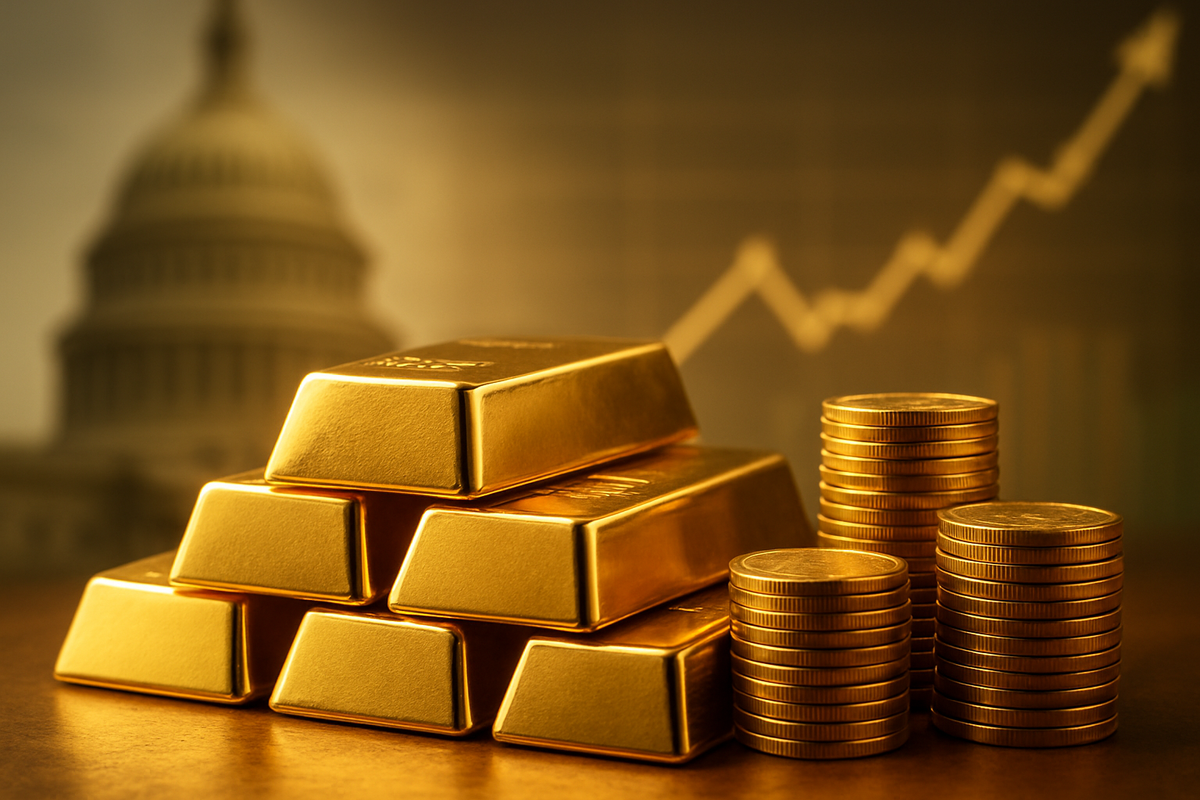
In early November 2025, the precious metals market witnessed a significant surge, with gold prices climbing to a three-week high. This rally was largely attributed to the anticipated resolution of a protracted 40-day US government shutdown, signaling a potential return to governmental stability and a clearer economic outlook. The prospect of an end to the fiscal impasse, combined with underlying economic concerns that hinted at imminent Federal Reserve interest rate cuts, created a potent bullish cocktail for bullion. Investors, grappling with both political uncertainty and signs of a softening economy, turned to gold as a hedge, pushing its value upwards.
The market's reaction was swift and decisive. As politicians in the US Senate made tangible progress towards ending the prolonged shutdown, spot gold prices jumped by 0.6% to an impressive $4,140.60 per ounce, briefly touching an intraday high of $4,148.75. This movement underscored the market's sensitivity to political stability and economic data flow. The shutdown had not only cast a pall of uncertainty over the economy but also halted the release of crucial economic indicators, leaving investors in the dark. The imminent reopening promised a resumption of this data, which, following reports of October job losses and consumer sentiment hitting a 3.5-year low, was widely expected to bolster the case for the Federal Reserve to implement further interest rate cuts. Indeed, traders were pricing in a substantial 64% probability of a quarter-point rate cut in December, with some analysts even speculating about a larger half-point reduction. Concurrently, silver also mirrored gold's ascent, reaching a near three-week high of $50.21 per Troy ounce, further solidifying the sentiment that precious metals were poised for a rally.
Companies Poised to Win or Lose in the Wake of Bullion's Rise
The surge in gold prices following the anticipated end of the government shutdown presented a clear advantage for companies operating within the precious metals sector, while the broader economic implications could have a more nuanced impact on others.
Winners: Gold mining companies stand to be significant beneficiaries. A sustained increase in gold prices directly translates to higher revenues and potentially improved profit margins for producers. Major players like Barrick Gold (NYSE: GOLD) and Newmont (NYSE: NEM) would see the value of their reserves appreciate and their extraction efforts become more profitable. Similarly, companies involved in silver mining and exploration would also benefit from the concurrent rise in silver prices. Furthermore, exchange-traded funds (ETFs) that track gold and silver prices, such as SPDR Gold Shares (NYSEARCA: GLD) and iShares Silver Trust (NYSEARCA: SLV), would experience increased investor interest and asset appreciation, offering a straightforward avenue for investors to capitalize on the bullion rally. Companies providing services to the mining industry, from equipment manufacturers to exploration consultancies, could also see increased demand as mining operations become more lucrative.
Potential Losers (or those facing challenges): While the immediate impact of the gold rally is positive for precious metals, the underlying reasons—economic weakness and anticipated rate cuts—could pose challenges for other sectors. Companies highly sensitive to consumer spending or those with significant debt burdens might face headwinds if the economic slowdown persists despite the government reopening. A weaker US dollar, which often accompanies lower interest rates and supports gold, could make imports more expensive for some domestic businesses. However, in this specific scenario, the "losers" are less about direct negative impact from the gold rally itself and more about the broader economic conditions that fueled the rally. The return of government stability, while broadly positive, doesn't instantly erase the economic vulnerabilities that necessitated a safe-haven flight to gold in the first place.
Wider Significance: A Confluence of Stability, Uncertainty, and Monetary Policy
The gold rally in early November 2025 was more than just a reaction to a political event; it was a complex interplay of political stability, lingering economic uncertainty, and the powerful influence of anticipated monetary policy shifts. This event highlighted several broader industry trends and mechanisms that govern the precious metals market.
Firstly, it underscored gold's enduring role as a safe-haven asset. While a government shutdown initially boosts demand for gold due to uncertainty, its resolution can also trigger a rally if it aligns with other factors, such as clearer signals for central bank action. In this case, the end of the shutdown was expected to restart the flow of economic data, which was anticipated to confirm the need for Federal Reserve rate cuts. Lower interest rates reduce the opportunity cost of holding non-yielding assets like gold, making it more attractive relative to interest-bearing investments. This mechanism is a critical driver for gold prices, often outweighing the initial reduction in political uncertainty.
Secondly, the event showcased the ripple effects on currency markets and other commodities. Gold is typically priced in US dollars, so a weakening dollar, often a consequence of anticipated rate cuts, makes gold more affordable for international buyers, further boosting demand. While the immediate end of a shutdown might temporarily strengthen the dollar by reducing uncertainty, the longer-term outlook influenced by monetary policy expectations can dictate its trajectory. Other commodities, particularly those used as industrial inputs, might not experience the same safe-haven boost as gold but could be affected by the broader economic sentiment and dollar movements.
Historically, US government shutdowns have had varied impacts on gold. The October 2013 shutdown saw an initial rally followed by a decline, only for gold to rise again towards its conclusion. The 2018-2019 shutdown, while seeing a modest gain during the impasse, was often described as "almost a non-event" for gold in its aftermath. The November 2025 scenario, however, distinguished itself by the strong alignment of the shutdown's end with clear signals of economic weakness and the high probability of aggressive Federal Reserve easing, creating a more robust and immediate bullish impulse for bullion. This particular convergence of factors—political resolution enabling economic data clarity, leading to anticipated monetary easing—provided a unique catalyst for the gold rally, demonstrating that the specific economic context is paramount.
What Comes Next: Navigating the Post-Shutdown Landscape
The immediate aftermath of the US government shutdown's end and the subsequent gold rally presents a dynamic landscape for investors and markets, with both short-term and long-term possibilities.
In the short term, attention will undoubtedly pivot to the Federal Reserve's next moves. The resumption of economic data releases will be crucial, providing clearer insights into the health of the US economy. Should the data confirm persistent weakness, reinforcing the case for aggressive rate cuts, gold could see continued upward momentum. However, if the economic indicators prove more resilient than anticipated, or if the Fed adopts a more cautious stance, some of gold's recent gains could be tempered. Market volatility is likely to remain elevated as investors digest new information and adjust their expectations. Strategic pivots for investors might involve closely monitoring inflation data, employment figures, and consumer confidence reports, all of which will influence the Fed's policy decisions.
Looking further ahead, the long-term trajectory of gold will depend on a confluence of factors, including the global economic outlook, geopolitical stability, and the ongoing debate around inflation. Gold's role as an inflation hedge could become more prominent if massive fiscal and monetary stimuli lead to inflationary pressures down the line. Conversely, a strong global economic recovery that normalizes interest rates could reduce gold's appeal. Market opportunities may emerge in diversified portfolios that include precious metals as a hedge against systemic risks, while challenges could arise from sudden shifts in central bank rhetoric or unexpected improvements in economic conditions that reduce safe-haven demand. Potential scenarios range from a sustained bull run for gold if economic weakness and loose monetary policy persist, to a more subdued performance if global growth accelerates and interest rates begin to normalize.
Comprehensive Wrap-up: Gold's Enduring Appeal Amidst Shifting Tides
The gold rally in early November 2025, sparked by the anticipated end of the US government shutdown, serves as a compelling case study in the intricate dance between political stability, economic health, and monetary policy. The key takeaway is the powerful interplay of these factors: while the immediate cessation of political uncertainty might typically dampen safe-haven demand, in this instance, it facilitated the clarity needed for monetary policy adjustments that were inherently bullish for gold. The market's quick reaction underscored gold's enduring appeal as a safe haven, but also its keen sensitivity to interest rate expectations and the availability of reliable economic data.
Moving forward, the market will remain highly attuned to macroeconomic indicators and central bank communications. The Federal Reserve's subsequent interest rate decisions will be paramount, as will the broader trajectory of the US and global economies. Investors should continue to watch for signs of inflation, any shifts in geopolitical stability, and the overall health of financial markets, all of which can influence gold's attractiveness. The events of November 2025 reinforced that gold is not merely a reactive asset to immediate crises but also a forward-looking indicator, often anticipating broader economic and monetary trends. Its lasting impact highlights that even as political impasses resolve, underlying economic vulnerabilities can continue to fuel demand for precious metals as a strategic component of a resilient investment portfolio.
This content is intended for informational purposes only and is not financial advice







